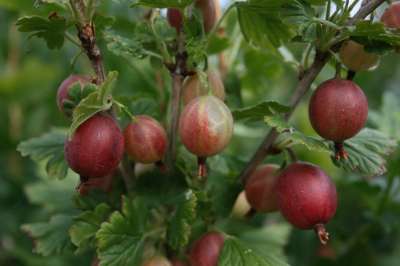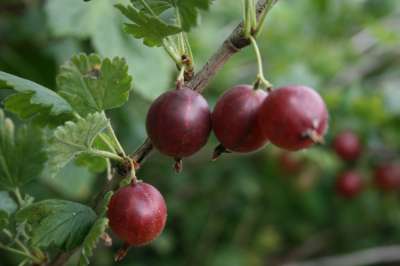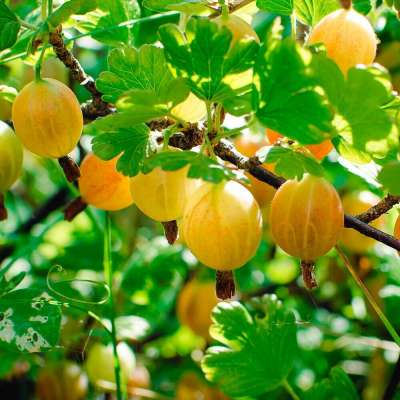Your basket is currently empty!
The sweetest dessert Gooseberries offer a distinct and delicious alternative to the more commonly known culinary varieties, these select few, mostly older cultivars, are often fondly remembered from childhood days as ‘gooseberries you could eat straight off the bush’ For those familiar only with the cooking varieties, this might seem a strange idea, but indeed with the right choice of varietiesm you really can grow gooseberries sweet enough to pop straight into the mouth and eat whole! Thin skinned, sweet and so delicious, it’s not surprising they are remembered with such fondness.
Buy our Gooseberry Bushes here.
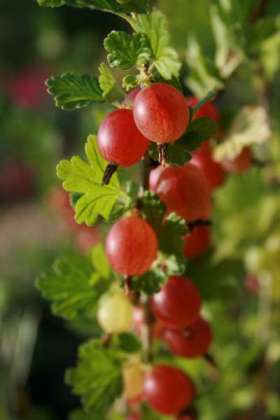
You have to be careful with variety selection – the more familiar cooking varieties outnumber those that are sweeter, and they tend to be the red or yellow skinned varieties. With few exceptions they are mostly quite old kinds as well, which leads to a few considerations when it comes to cultivation. As far as growing methods and the basic principles are concerned, there isn’t really any difference. But if you want the very sweetest berries, and the best quality too, there are a few pointers to be remembered.
Gooseberry Bush Cultivation
Spacing the Gooseberry Bushes
Allow about 5-6’ between bushes; 18-24” for cordons. That’s the same for all varieties, although you might find these heirloom varieties are a bit less vigorous so you can get away with a little less. They can grow to 5’ or so in height, but don’t be afraid to trim them back a little if necessary, it should also be remembered that a lot of these old varieties don’t have that much vigour so will probably stay smaller.
Mildew
Is the one common-denominator that you must protect from since few, if any of these types have any natural resistance? The powdery mildew will cover not only the new growths, but also the berries themselves, rendering them useless. It’s worth taking a few p[recautions to safeguard your crop. You can spray, of course – various fungicides are available that will do the job and as long as you start early, as a prevention rather than a cure, it’s fairly easy to keep the disease at bay. But you must start soon after the leaves have emerged, and continue until the fruits are beginning to swell.
Cultivation techniques can also help ward off mildew and I think it’s preferable to grow these varieties as cordons which allows for more light and air to permeate around the leaves and the growth is less congested than with bushes – it naturally discourages mildew to a certain extent. You can grow single cordons – which have just one main stem – or double cordons – which of course have two. You may even grow triples, with 3 stems, or fan train them, but for ease and practicality single or double is most often recommended.
Feeding
Feeding is an important consideration as well – as has been noted earlier in this article, some of the rather older types won’t show that much vigour so will benefit with feeding, but on the other hand don’t over do it and don’t use high nitrogen feeds because soft lush growth will be more prone to mildew. Bonemeal or growmore applied to the base of the bush in early spring and lightly raked into the soil and watered in is perfect and it helps develop a strong root system.
When growing as bushes allow for more space around the bushes, rather than less to emphasise air flow and choose a sunny spot. Normally gooseberries can cope with some shade but mildew will be more rife there. And now we come to the second major consideration …..
Getting the Sweetest Tasting Berries
Which means lots, and lots of sunshine! The more sun any fruit gets, then the sweeter it is because sunshine helps develop the sugar content in the fruit! So when evaluating exactly where you’re going to plant your dessert heirloom gooseberry varieties it’s worth affording the warmest, sunniest spot you can find. This applies to bushes, and also cordons which will benefit from a South or West facing aspect, a nice warm wall or fence maybe. Bushes should be pruned to promote an open habit, so sun can penetrate inside the bush as well. And lastly, make sure that water is freely given during the key period as the berries start to plump up, in May and June. Remember you want juicy berries as well as sweet ones! Once a day, puddle the area beneath the bush with a hose until the soil is nicely damp or slightly wet. Take extra care not to splash the foliage or the developing fruits, make sure the hose is right near the ground – and make sure the pressure isn’t so great that it splashes the fruits formed on the lower branches. A temporary mulch of bark chippings will help in this respect and also keeps the moisture in. Watering is best done early in the morning, or in the evening, when it is cooler.
Consider Grow them as Standards
Another ideal way of growing the dessert varieties is as the standard form. The advantage of this is that the berries receive more sunshine, which they crave to accentuate the flavour. A standard Gooseberry bush has a stem of about 1 metre in length [sometimes this can vary according to the nursery that grows them and all depends on where the bush was grafted onto the stem] but 1 metre is a good average and is the stem length you will usually receive from our nursery. This keeps the bush well clear of the ground and so it receives more sunshine all the way around the main growth. The stem itself is kept clear, rather like a standard rose. Such types are also easier to harvest with no bending. It’s not easy to find standard gooseberries for sale, so you will need to contact a specialist grower for availability and it also tends to be the more common varieties that are grown as such.
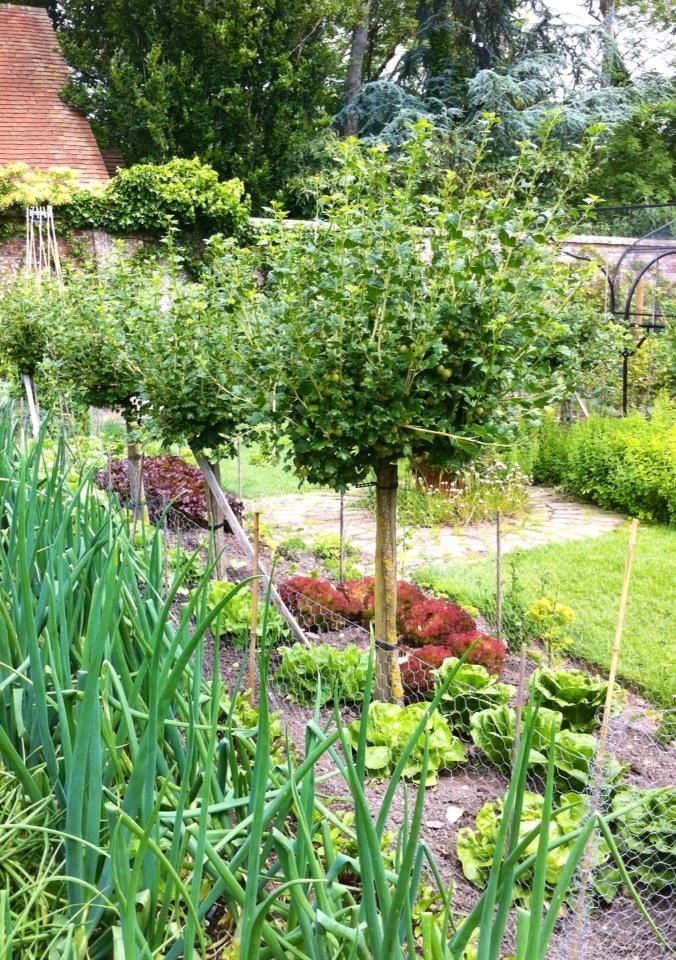
When to Pick Gooseberries – Don’t Harvest Too Soon!
To allow the flavour and sugars to develop fully, don’t be tempted to pick the fruits too soon. Normally they still aren’t fully ripe until a week or ten days after turning colour. The fruits should part from the branches without too much of a struggle, and if they have a little ‘give’ in them that’s a good sign too.
Remember you can use these berries for all cooking purposes too, pies and jams etc is fine, and the sweeter taste is carried through into any cooked produce. The red varieties in particular give a wonderfully rosy red coloured jam! But, if you do want gooseberries for cooking purposes, make sure you grow the culinary varieties too as the more powerful flavour makes for the best baking and jams in my opinion.
Varieties
Here’s a run-down of the best and most delicious sweet dessert varieties. So many old heirloom types have been lost to cultivation over the years, but we are fortunate to have maintained a good selection. These are our – and your – favourites – together with some you may well not have come across.
EARLY SULPHUR Gooseberry Bushes
Usually the first to ripen so a very valuable variety to have, sometimes it can be eaten in late May or early June. The fruits are moderately sized and ripen to a pretty primrose yellow and have a really first class flavour. One of the better older varieties which all but disappeared from use in the UK but was rescued and brought back from Europe.
Definitely one of the finest reds and useful in that it can be used as a dual purpose gooseberry – frequently used in the kitchen whilst green, and then enjoyed for dessert when fully ripe, whereupon it is a fine dark red. Ripening late May and early June, the skin is quite smoth and downy which makes it especially good for eating fresh. The growth of the bush is quite upright and easy to manage.
One of the few newer varieties in this class and at last, a red that has mildew resistance! This fine lusty grower has good dark, glossy foliage and tends to outyield older varieties too with berries of high quality. They ripen to an even medium red and are perfectly sweet and moreish! Berries are amongst the largest you will find and the vigorous growth is easy to manage. Highly recommended, ready for picking early June.
BLACK VELVET Gooseberry Bushes
An exciting speciality, this hybrid variety exhibits strong, vigorous growth and noticeably fewer spines than most. The fruits are fairly small but very prolific, smooth, deep red-almost black in colour and entirely sweet and more-ish!
Exhibition quality no less, the large fruits ripen from olive green to pale yellow and when properly developed have a superb flavour. The fruits are oval and can be plucked early-mid June. An old rarity that remains well worth growing!
As far as dessert gooseberries go, this is a luminary and one of the most oft-requested of all varieties. An angular grower, and far from the heaviest cropping, but the fruits are large and sumptuous to eat with a rich, divine flavour. The skin colour is yellow when fully ripe, which is usually about mid June at which time it develops a characteristic, almost greengage type flavour. Suits cooking purposes admirably, but first and foremost a dessert variety. Fruits are fewer but larger than most, tends to be sparsely foliated.
WHINHAMS INDUSTRY Gooseberry Bushes
Quite an easy variety to grow, which suits all soil types. Vigorous and productive, medium sized berries ripening to medium red, good sweet flavour. Mid season – mid June onwards, the berries hang on the bush for some time in good condition. A good staple variety for any collection. Which suits all areas.
A rarity and a change with it’s pale whitish skin colour and mild, sweet taste. The long white berries become almost transparent when fully ripe, and are thin skinned. Does particularly well as cordons, the fruits are borne along the full length of the branches, which makes for easy picking. Season mid-late June.
Another newer type and a valuable mildew resistant red! Rokula is an ideal garden variety for low maintenance cultivation and the large dark red berries have a superb flavour. Heavy yielding with excellent clean growth, you can harvest Rokula early-mid June. There will be plenty for freezing, pies and jams too, and a delight to pick and eat straight from the bush as you pass by! Highly recommended and already very, very popular. Suits all growing methods, be it bush, cordon or standard.
A luminary that is often considered to have the finest dessert flavour of all, the eating pleasure is accentuated further by the thin skin, deep golden yellow colouring, and aroma! A small, relatively weak growing bush with a somewhat spreading habit, but fairly durable nonetheless, the berries are small and freely produced, ripening mid-late seaon – late June and July depending on the method of cultivation and the locality.
A good European variety that is seldom vaunted but deserves more attention. A good dessert flavour from the moderately sized shiny deep ruby red attractive fruits which have a high sugar content. Relatively healthy, semi vigorous and easy to grow, fruits are borne in profusion ripening late June. Suits cooking purposes as well, well worth growing.
One of the most popular of the oldies with a very fine sugary aromatic flavour and a rich deep ruby skin colouring. Despite it’s name, not especially spiny, at least no more so than the next variety! The bush tends to be quite upright growing which makes it easy to maintain as a bush and also ideal for cordons. Described as having the ‘perfect dessert flavour’ this heirloom has been known for over 100 years.
Has claims as one of the largest of berries, and they ripen to a fine deep red too. Full of flavour and juice, suits exhibition as well as dessert use. Not the heaviest cropper as might be expected, but impressive and the fruits are of good quality too. Has some mildew resistance; well worth growing.
LANCASHIRE LAD Gooseberry Bushes
This oldie likes good conditions to do well but results can be impressive when well grown and the taste never disappoints. Quite late ripening, red fruits.
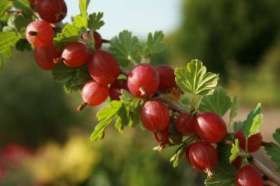
A useful, more vigorous and easy growing variety with good foliage and relatively large white-green fruits that have a mild, sweet taste. Also valuable as a late ripening season extender, habging well into July. Thin skinned, juicy and luscious, a rarity that does well here.
Every Gooseberry lover will likely want to grow one or two of these specialities, either to re-live memories of childhood, or to enjoy the excitement of a new taste experience, either way with a little forethought and planning you won’t be disappointed! They certainly deserve that little bit of extra tender loving care.




